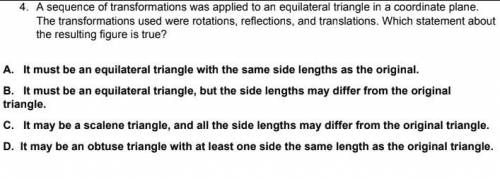
Mathematics, 09.04.2021 19:10 dozsyerra
A sequence of transformations was applied to an equilateral triangle in a coordinate plane.
The transformations used were rotations, reflections, and translations. Which statement about
the resulting figure is true?
A. It must be an equilateral triangle with the same side lengths as the original.
B. It must be an equilateral triangle, but the side lengths may differ from the original
triangle.
C. It may be a scalene triangle, and all the side lengths may differ from the original triangle.
D. It may be an obtuse triangle with at least one side the same length as the original triangle.


Answers: 1


Another question on Mathematics

Mathematics, 21.06.2019 13:00
Harry’s soccer team plays 2 nonconference games for every 3 games that they play against conference opponents. if y represents the number of nonconference games and x represents the number of conference games, which equation best models this proportional relationship? a)y=2/3 x b)y=3/2 x c)y = 2x d)y = 6x
Answers: 1

Mathematics, 21.06.2019 15:00
What are the relative frequencies to the nearest hundredth of the columns of the two-way table?
Answers: 2

Mathematics, 21.06.2019 18:00
You paid 28.00 for 8 gallons of gasoline. how much would you pay for 15 gallons of gasoline?
Answers: 1

Mathematics, 21.06.2019 21:30
On #16 : explain how factoring a trinomial, ax^2+ bx+ c, when a does not equal 1 different from factoring a trinomial when a = 1.
Answers: 2
You know the right answer?
A sequence of transformations was applied to an equilateral triangle in a coordinate plane.
The tra...
Questions






Mathematics, 08.09.2021 02:00


Biology, 08.09.2021 02:00


Mathematics, 08.09.2021 02:00

Mathematics, 08.09.2021 02:00

Social Studies, 08.09.2021 02:00



Mathematics, 08.09.2021 02:00


Mathematics, 08.09.2021 02:00

Mathematics, 08.09.2021 02:00

Mathematics, 08.09.2021 02:00

Mathematics, 08.09.2021 02:00



